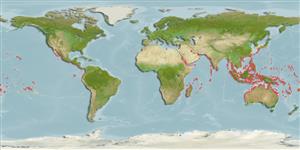Common names from other countries
Environment: milieu / climate zone / depth range / distribution range
Ecología
Asociado a arrecife; rango de profundidad 0 - 10 m (Ref. 96968). Tropical
Distribución
Países | Áreas FAO | Ecosistemas | Ocurrencias, apariciones | Introducciones
Indo-Pacific.
Length at first maturity / Tamaño / Peso / Age
Maturity: Lm ? range ? - ? cm Max length : 120 cm TL macho / no sexado; (Ref. 96968); peso máximo publicado: 1.0 kg (Ref. 96968)
It's mantle length is 13 cm (Ref. 96968). Minor harvests are known within the region. Occurs in shallow tropical (Ref. 96968) and subtropical waters (Ref. 106867) on coral reefs (Refs. 96968, 106867). Occupies temporary lairs within coral rubble with deep vertical holes as entrance, which are sealed during the day with rubble. At night, it forages over reef flats or at gravel substrate on sandy bottoms during low tide. Primarily feeds on fishes, crustaceans and octopuses (Ref. 101159).
Life cycle and mating behavior
Madurez | Reproducción | Puesta | Huevos | Fecundidad | Larva
Members of the class Cephalopoda are gonochoric. Male and female adults usually die shortly after spawning and brooding, respectively. Mating behavior: Males perform various displays to attract potential females for copulation. During copulation, male grasp the female and inserts the hectocotylus into the female's mantle cavity where fertilization usually occurs. Life cycle: Embryos hatch into planktonic stage and live for some time before they grow larger and take up a benthic existence as adults.
Wood, J.B. and C.L. Day. 1998. (Ref. 3722)
IUCN Red List Status (Ref. 130435)
CITES status (Ref. 108899)
Not Evaluated
Not Evaluated
Human uses
Pesquerías: escaso valor comercial
| FishSource | Sea Around Us
Herramientas
Más información
Age/Size
Crecimiento
Length-weight
Length-length
Morfología
Larva
Abundancia
Fuentes de Internet
Estimates based on models
Preferred temperature
(Ref.
115969): 24.3 - 29.3, mean 28.3 (based on 4166 cells).
